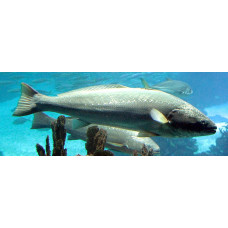Latin name
Argyrosomus regius
Other names
Сroaker, shade-fish, sowa, kir, corvina, salmon-bass, stone bass
Identification
Body elongated, rather low, compressed at the sides, covered with ctenoid scales. The scales are cycloid on the thorax, snout and under the eyes. The head is large with a slightly slanting terminal snout. The chin tendril is absent. The eyes are small. The lateral line is well defined, starting at the head, running down the middle of the body, bending slightly downwards near the soft part of the dorsal fin and entering the caudal fin. Very large otoliths. Swim bladder with numerous protuberances.
Features of fish fins
The dorsal fin is simple, with a deep notch separating the barbed and soft parts. The base of the barb is much shorter than the base of the soft. The barb has 9-10 barbs, with the second barb twice as long as the first. The soft part has one barb and 26-29 soft rays. In the anal fin, the first barb is short and the second barb is long and thin, followed by 7-8 soft rays. The caudal fin is truncated, sometimes the middle rays are elongated.
Fish colouring
The body is silver grey with a bronze tinge to the dorsum and sides. Fins are greyish with reddish bases. The mouth cavity is golden orange.
Distribution
Widespread in the eastern Atlantic from Norway to Senegal, found in the Mediterranean and Black Seas.
Habitat
Marine benthopelagic fishes. They inhabit coastal and continental slopes. Fish are found both near the bottom and in the middle layers of the water at depths of 15 to 300 metres. Occupy estuaries.
Size
Maximum body length 230 cm, usually up to 150 cm, mass up to 103 kg.
Behavior
Predators. Active at dusk and night. During the day, fish hide on the bottom or rocks and can remain motionless for long periods. They swim fast enough and can change direction on a dime. Fish have good visual and olfactory senses, allowing them to find prey and avoid danger.
Food and feeding habits
Juveniles of one year of age feed on small demersal fish and crustaceans (mysids and shrimps). When they reach 30-40 cm in length, they switch to feeding on fish (mainly herring and mullet). The diet also includes cephalopods and crustaceans.
Reproduction
In mid-April, sexually mature individuals begin their spawning migration to coastal waters. The main spawning grounds are in the Nile Delta, off the coast of Mauritania and off the Atlantic coast of France (Gironde). They spawn in May-June near the coast and in estuaries. During the spawning season the males make a characteristic grunting sound that can be heard up to 30 metres away. The sound is produced by the contraction of abdominal muscles and the swim bladder acts as a resonator. Spawning takes place at a temperature of 17-22°C. The fecundity of females, which are 1.2 m long, is 800,000 eggs. The diameter of fertilised eggs is 990 microns. The eggs have a fat droplet. The larvae are pelagic, but the 3.7 cm long juveniles are already benthic.
In mid-June to July, spawning individuals leave the estuaries and feed close to shore at shallow depths. In winter, silver humpbacks move to deeper areas. Juveniles leave the estuaries in late summer and migrate to coastal waters, where they spend the winter at depths of 20-40m. They return to the estuaries in mid-May of the following year to feed.
Fishing
They are of commercial importance. Fishing is carried out by trawls and longlines. Popular object of sport fishing.
| Classification | |
| Phylum | Chordata |
| Class | Actinopterygii |
| Squad | Acanthuriformes |
| Family | Sciaenidae |
| Genus | Argyrosomus |
| Species | A. regius |
| Features | |
| Conservation status | Least Concern |
| Habitat | Pelagic |
| Life span, years | No information |
| Maximum body weight, kg | 103 |
| Maximum length, cm | 230 |
| Sailing speed, m/s | No information |
| Threat to people | Edible |
| Way of eating | Predator |
Meagre
Tags: meagre



